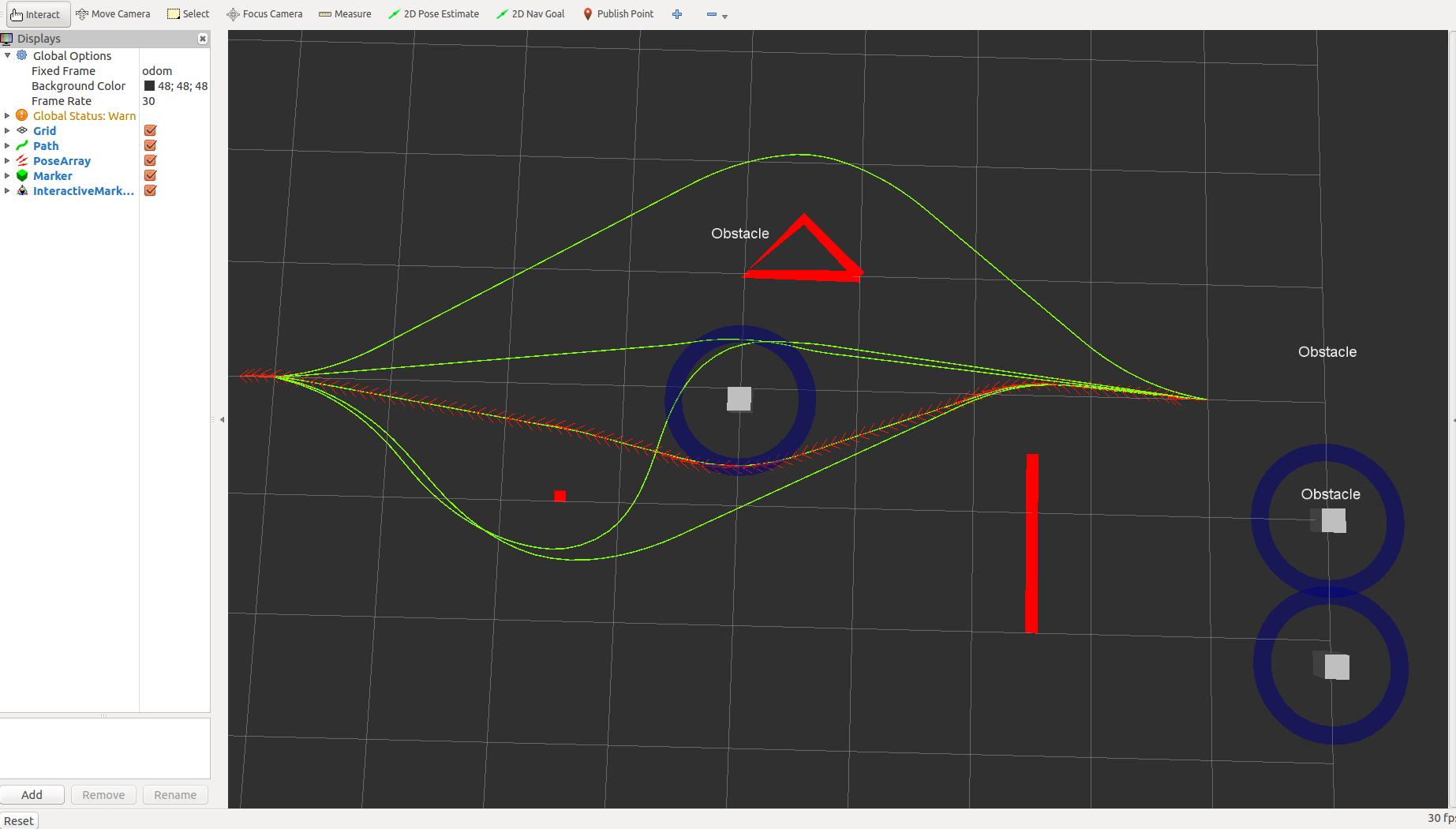| Note: This tutorial assumes that you have completed the previous tutorials: Set up and test Optimization. |
| |
Incorporate customized Obstacles
Description: In this tutorial you will learn how to take polygon-shaped obstacles published from other nodes into account.Keywords: Trajectory Optimization Local Planner Navigation Obstacles Polygon
Tutorial Level: INTERMEDIATE
Next Tutorial: Incorporate dynamic obstacles
Introduction
For some applications you might not want to rely on a costmap or you want to add other than point-obstacles. In that case you can send your own obstacle list to the teb_local_planner package using a specific topic (~<name>/obstacles).
The underlying message-type costmap_converter/ObstacleArrayMsg is part of the costmap_converter package. The message specifies the following obstacle types:
- Point obstacle: provide a polygon with a single vertex
- Circular obstacle: provide a polygon with a single vertex and a non-zero radius value.
- Line obstacle: provide a polygon with two vertices
- Polygon obstacle: provide a polygon with more than 2 vertices; the polygon will be considered to be closed between the last and the first vertex.
Write a simple Obstacle Publisher
In the following, we will create a small python node that publishes a few obstacles. For the planning part, we will run the test_optim_node described in the tutorial Set up and test Optimization. Alternatively, you could also test your publisher using a properly configured navigation launch file according to Configure and run Robot Navigation.
Create a python node called publish_obstacles.py:
1 #!/usr/bin/env python
2 import rospy, math
3 from costmap_converter.msg import ObstacleArrayMsg, ObstacleMsg
4 from geometry_msgs.msg import PolygonStamped, Point32
5
6 def publish_obstacle_msg():
7 rospy.init_node("test_obstacle_msg")
8
9 pub = rospy.Publisher('/test_optim_node/obstacles', ObstacleArrayMsg, queue_size=1)
10
11 obstacle_msg = ObstacleArrayMsg()
12 obstacle_msg.header.stamp = rospy.Time.now()
13 obstacle_msg.header.frame_id = "odom" # CHANGE HERE: odom/map
14
15 # Add point obstacle
16 obstacle_msg.obstacles.append(ObstacleMsg())
17 obstacle_msg.obstacles[0].id = 0
18 obstacle_msg.obstacles[0].polygon.points = [Point32()]
19 obstacle_msg.obstacles[0].polygon.points[0].x = 1.5
20 obstacle_msg.obstacles[0].polygon.points[0].y = 0
21 obstacle_msg.obstacles[0].polygon.points[0].z = 0
22
23 # Add line obstacle
24 obstacle_msg.obstacles.append(ObstacleMsg())
25 obstacle_msg.obstacles[1].id = 1
26 line_start = Point32()
27 line_start.x = -2.5
28 line_start.y = 0.5
29 line_end = Point32()
30 line_end.x = -2.5
31 line_end.y = 2
32 obstacle_msg.obstacles[1].polygon.points = [line_start, line_end]
33
34 # Add polygon obstacle
35 obstacle_msg.obstacles.append(ObstacleMsg())
36 obstacle_msg.obstacles[1].id = 2
37 v1 = Point32()
38 v1.x = -1
39 v1.y = -1
40 v2 = Point32()
41 v2.x = -0.5
42 v2.y = -1.5
43 v3 = Point32()
44 v3.x = 0
45 v3.y = -1
46 obstacle_msg.obstacles[2].polygon.points = [v1, v2, v3]
47
48 r = rospy.Rate(10) # 10hz
49 t = 0.0
50 while not rospy.is_shutdown():
51
52 # Vary y component of the point obstacle
53 obstacle_msg.obstacles[0].polygon.points[0].y = 1*math.sin(t)
54 t = t + 0.1
55
56 pub.publish(obstacle_msg)
57
58 r.sleep()
59
60 if __name__ == '__main__':
61 try:
62 publish_obstacle_msg()
63 except rospy.ROSInterruptException:
64 pass
Here we skip breaking the code down since creating a publisher and publishing messages is explained well in the beginner tutorials section (see here).
Now run the teb_local_planner test_optim_node in combination with rviz:
roslaunch teb_local_planner test_optim_node.launch
In the following, we assume that your package containing the python script is called mypublisher. Make sure that your script is marked as executable (chmod +x publish_obstacles.py). Open a new terminal and run your newly created python script:
roslaunch mypublisher publish_obstacles.py
The visualization in rviz should now look similar to the one shown in the following figure: 
Related Parameters
Parameters that influence planning with custom obstacles are listed here (refer to the Node API for more details):
~<name>/min_obstacle_dist: Desired minimal distance from obstacles
~<name>/include_costmap_obstacles: Deactivate costmap obstacles completely
~<name>/costmap_obstacles_behind_robot_dist: Maximum distance behind the robot searched for occupied costmap cells.
~<name>/obstacle_poses_affected: Specify how many trajectory configurations/poses should be taken into account next to the closest one.
~<name>/weight_obstacle: Optimization weight for keeping a distance to obstacles.
~<name>/footprint_model: The robot footprint model







